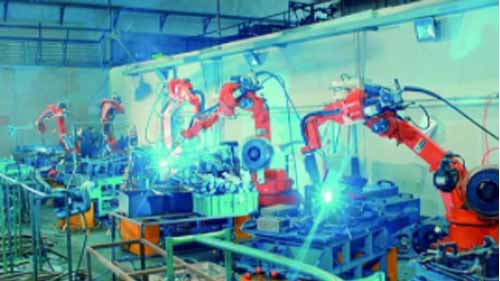
It is now possible to find an industrial robot for almost any manufacturing process that you engage in. The trick, however, lies in understanding which type of robot would be best-suited to fulfill various tasks. Unfortunately, this is something that most manufacturers struggle with as the concept of robotics can be somewhat complex.
In a nutshell, industrial robots are differentiated by factors such as flexibility, reach, and payload capacities. When making your choice, these are likely the design factors you would need to weigh against your factory operations. To help you make the right choice for your factory, here is a can’t-miss list of robot types and how they can be applied.
Table of Contents
Articulated Robots
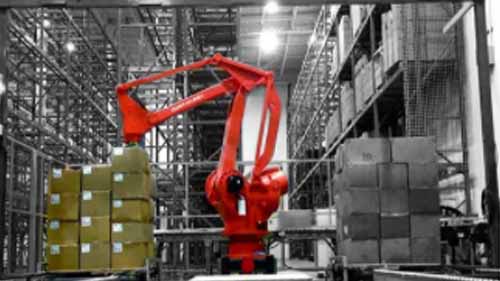
Articulated robots are highly flexible robots made up of numerous rotary joints. These joints enable them to move along multiple planes and thus, depending on the number of joints, they can have up to ten axes. 6-axis robots are currently the most prevalent articulated robots but newer designs have advanced to 7 axes. Their robot arms are powered by multiple motors fitted inside them.
The high amount of dexterity that articulated robots have makes them ideal candidates for complex industrial applications. They can reach under, over, or pitch and yaw to access objects in processing machines and fulfill different tasks much like a human hand would. This is further enhanced by the use of different end-of-arm tools that correspond with the task.
Additionally, quality articulated robots in the market have well-managed cords, ingress protection, and sealed joints. They are thus qualified for application in high-moisture, high heat, and cleanroom industrial processes. Thanks to their flexibility, they can also be mounted in a variety of ways depending on what would be ideal for your factory space
Pros:
High flexibility
Can perform complex tasks
Multiple styles of installation to suit different industrial processes
Cons:
They can be slower due to their weight and multiple joints of articulation
They are expensive
Recommended Applications
You can harness the flexibility of an articulated robot to automate operations such as:
Machine tending
Packaging products
Product inspection
Product assembly
SCARA Robots
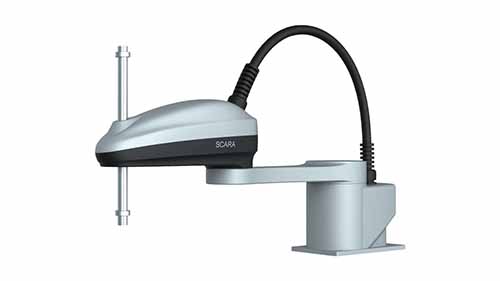
A SCARA robot is a Selective Compliance Articulated Robot Arm. This acronym refers to its limited flexibility whereby it can move along the X and Y axes but is rigid in the Z-axis. This means that a SCARA robot arm can move left, right, back, and forth. Its rigidity on the Z-axis means it can move vertically as well but on a fixed axis. Due to their small work envelope and compact size, SCARA robots can be quite fast.
It is these design provisions that make SCARA robots suitable for the industrial assembly of small parts. In manufacturing circuit boards, for example, a SCARA robot can be programmed to pick microparts from a tray and insert them on the board. Aside from assembly, they can also be applied in repetitive tasks that require the transfer of objects between two parallel planes.
Pros:
Compact work envelope
They work fast
They have high precision and repeatability
Cons:
They typically have low payload capacities
Limited flexibility results in limited application possibilities
Recommended Applications
Product part assembly
Product inspection
Pick and place
Delta Robots
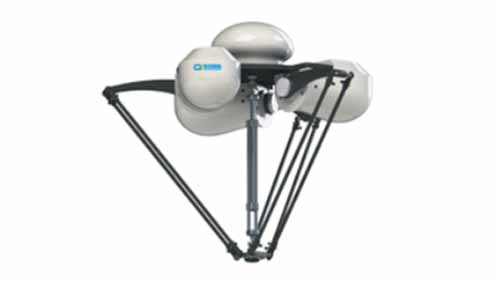
A delta robot consists of 3 parallel robotic arms mounted on a stationary base. The robotic arms have both prismatic and rotary joints and are powered by 3 motors fitted inside the base. This design gives the arms of a delta robot added stability but only allows them to be flexible in the X and Y-axis. However, with the motors being installed in the base as opposed to the arms, the arms are lightweight and thus delta robots are very fast.
The design of delta robots requires that they be mounted overhead such that the robot arms hang downwards. This makes them a good candidate for in-line industrial functions like sorting products on a conveyor belt. They can also be innovatively customized with add-ons like sensors or visual systems to enhance their accuracy and overall performance.
Pros:
High-speed operation
Compact work envelope
High accuracy
Cons:
They have limited reach
Limited flexibility
They can only handle small payloads
Cartesian Robots
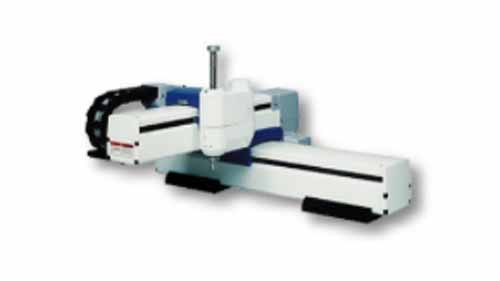
Source: processsolutions.com
Cartesian robots take up a cubical work envelope. They are assembled on-site and can be customized to fit particular applications. They consist of 3 or more linear actuators that are placed perpendicular to each other. For this reason, a Cartesian robot can only move along one axis at a time.
It is possible to mount a Cartesian robot vertically, horizontally, or overhead. However, when it is mounted overhead, it is referred to as a gantry robot though its functions largely remain the same. It is also during this installation phase that customization details such as the length of strokes and operation speeds are set.
Unlike articulated robots, cartesian robots can only achieve limited maneuvers. They can not, for instance, reach for parts and turn them. Their programming can equally be complex but you could explore models that come preprogrammed or separate programming tools.
Pros:
Multiple installation possibilities
High accuracy
They can be customized to match specific tasks
Cons:
Installation and programming can be complex
Only one axis can move at a time
Complexities can make it inaccessible to small scale firms
Recommended Applications
3D printing
Pick and place tasks
Product inspection
Polar Robots
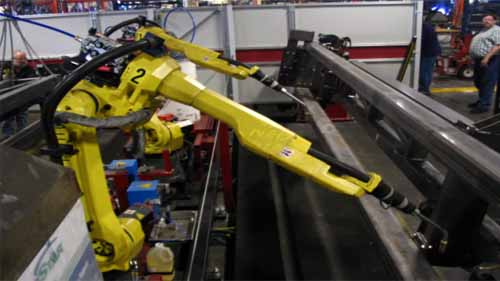
Source: prezi.com
A polar robot is made up of 4 main parts; a rotary base, an elevation pivot, an arm that can expand and retract like a telescope, and a retraction boom. It is used for simple tasks as it can not only extend to the area around the base of the robot. It can move along the XYZ axes but the points that the robot arm can reach are determined by how far it can stretch from the robot base.
The work angle of a polar robot is spherical. It can be installed either on the factory floor or a tabletop depending on its size and the task it is performing. Due to the structure of its arm and its retracting motions, a polar robot fares better in operations that do not require a lot of motion or high repeatability.
Pros:
A polar robot’s arm can maneuver over and under objects
They can cover a significant work envelope
Cons:
Low accuracy and repeatability
They are relatively slow
Their scope of applications is limited
Recommended Applications
Spot welding
Drilling
Die casting-
Injection molding
Cylindrical Robots
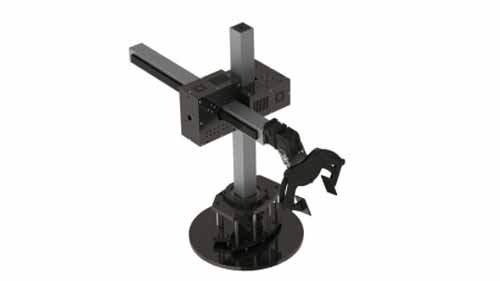
Source: pishrobot.com
The structure of a cylindrical robot is made up of a rotating shaft mounted on a base using a rotary joint. The rotating shaft is further perpendicularly connected to a robot arm that can expand, retract, and move vertically along the rotating shaft.
This compact design makes cylindrical robots a good choice for small-scale factories that do not have lots of factory floor space. They also cover a sizable cylindrical work envelope thanks to the rotating shaft which in turn moves the robot arm along a 360° plane. That said, the movements of a cylindrical robot are limited as its arm has little flexibility. Subsequently, there are only a few industrial processes that it can be applied in.
Pros:
They can cover a 360° work envelope
Larger designs can handle large payloads
Their compact structure takes up little room
Cons:
Limited flexibility
Limited applications
Low accuracy and repeatability
Recommended Applications
Loading and unloading machines
Foundry applications
Die-casting
Collaborative Robots
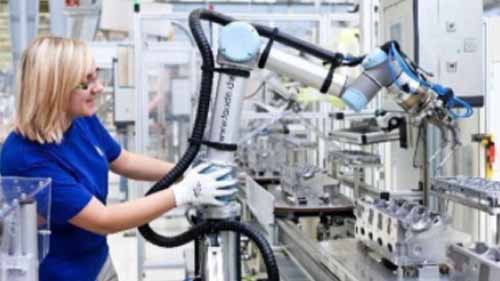
Source: Pinterest
Robots, while infinitely beneficial to the manufacturing industry can also pose a variety of risks. More so in factory operations where they have to work in the same spaces as human workers. Their ‘blind’ movements often result in injuries to staff and even collisions between separate robots.
Further, the initial design of industrial robots seemed to only envision robots working without the input of humans. As a result, they were built with pronounced sharp edges, and overall their designs were not particularly human-friendly. Yet, research has proven that manufacturing processes can greatly benefit from incorporating the different strengths of both human labor and robot capabilities.
The concept of collaborative robots seeks to address these dilemmas. By definition, collaborative robots are robots designed to be more human-friendly both in terms of safety and operation. As such collaborative robots are not necessarily defined by how many axes they have but rather how well they can co-work with human beings.
The main characteristics of a collaborative robot include:
Rounded edges– their edges are smoothed over with some even encased in plastic. This reduces the injuries that a worker would suffer by accidentally bumping into the robot while working alongside it.
Motion sensors– the robotic arms of collaborative robots are fitted with motion sensors that detect the presence of a human or an obstacle in their work envelope. The sensors can either trigger the arm to slow down or stop depending on how far the obstacle is.
Less noise– high decibels of noise can be damaging to human hearing. To make it possible for staff and robots to safely work together, collaborative design robots are built to minimize noise as much as possible.
Pros:
They are safer than other robots
They offer factories more value by harnessing both human and robotic prowess
Low noise design features generally improve the factory floor environment
They have a compact structure
Cons:
They can be expensive given the extra features
Conclusion
Each type of industrial robot presents a set of solutions for various applications. When you have a clearer understanding of how they work, it is much easier to identify which of them would be a good match for the needs of your factory. That said, the quality of work output that you get will only be as good as the quality of robots you invest in. Therefore, to crown it all, aim for an industrial robot manufacturer that uses quality inputs and offers innovative solutions.
